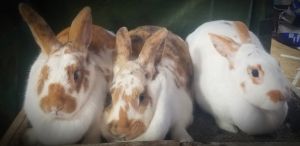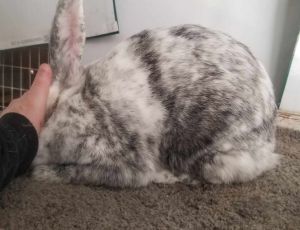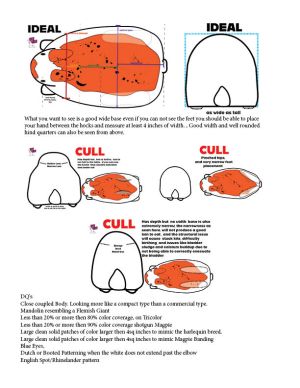Partiquin
== Partiquin "Senita" Project ==
The official Working Breed name will be Senita Partiquin Composites were bred by Mary-Margaret Conley in 2018. Stephanie Hughes joined the project in 2020, and Elizabeth Yardley Kangas came on board in 2023. Madison Simmons of Colorado Spring CO joined Fall of 2024 along with A few others who are helping with the project.
The Partiquin Composite " Senita " was started by crossing between a Japanese Harlequin-colored non-pedigreed Doe and a New Zealand red, then crossed back to a New Zealand broken Black.
Non-physical Traits[edit | edit source]
non-physical traits that are selected are inquisitive, friendly, happy rabbits, with great mothering ability,
physical traits[edit | edit source]
Senitas are known for their heat and cold tolerance. They have been thriving and doing binkies in temperatures ranging from 0 degrees to 100 degrees. They tend to have slightly larger ears and a slightly longer shoulder and midsection than New Zealands, typically 3-4 inches in proportion. A shorter shoulder and longer midsection are preferred, but not so long as to be mandolin-shaped. When viewed from above, they should be egg-shaped. Most Partiquins have larger litters, like Harlequins.
As of 2023, the Senita rabbit breed is still New Zealand-sized, which is between 9 and 12 pounds. However, Mary Conley has successfully bred rabbits that weigh up to 12 pounds and is slowly working on breeding them to weigh up to 16 pounds. Her goal is to increase their weight without sacrificing their commercial type or color.
Mary's litters are currently hitting 2 pounds, 10 ounces at 5 weeks. Her goal is to increase that to 4-5 pounds by 8 weeks. She's hoping to move those goals up as the litter size increases. To that end, she has incorporated a close-coupled Flemish cross doe and is seeking a shorter shoulder giant chin or nicely typed extra large line to incorporate.
Senita working Standard[edit | edit source]
A large rabbit of COMMERCIAL TYPE with Medium bone.
Weights[edit | edit source]
Jr Min weight 5lbs Jr Max Weight 10lbs
Int Min Weight 10.5lbs Int Max Weight 11.5lbs
Sr Min Weight 12lbs Sr Max Weight no max
Body[edit | edit source]
Body to be well muscled with excellent fullness front to back. Presenting an overall sense of balance. Full smooth loin. A gradual rise begining at the nape of the neck peaking over the center of the hips. A slight curve over the rear of the hindquarters to the table. Not undercut. Partiquins should have equal depth and width, with a gradual egg 🥚 shape when viewed from above.
Fault:
- Chopped Hindquarters
- Undercut hindquarters
- Pinched hindquarters
- Weak or low Shoulders
- Overly long shoulders( mandolin)
- Overly short shoulders(compact)
- Peak too far forward.
Coat[edit | edit source]
coat type is Roll-back coat. The Senita rabbit should have a thick coat that is approximately 1.5 inches long. The coat should be full, dense, and luxurious to demonstrate the dual purpose of this breed.
Fault:
Open or Dirty Coat
Varieties[edit | edit source]
- Japanese Brindled
- Magpie Brindle
- Broken/shotgun Magpie
- Tricolor
These varieties are shown in Rollback coats. Mismatched nail colors are allowed. , body type is to be weighed heavier in all varieties, over pattern clarity.
Even Brindled marking uniform over the whole body Color should be rich high rufus and have depth regardless of coat type.
FAULT[edit | edit source]
Less than 40% or more then 60% color coverage, on Tricolor
Less than 40% or more then 80% color coverage Broken Magpie
Solid patches Larger then 2-3.5 sq inches of any one color and large bands of Color Japanese Brindle color variety
Solid patches Larger then 2-3.5 sq inches of any one color and large bands of Color on Magpie Brindle varieties
DQ's[edit | edit source]
Close coupled Body. Looking more like a compact type than a commercial type.
Mandolin resembling a Flemish Giant
Less than 20% or more then 80% color coverage, on Tricolor
Less than 20% or more then 90% color coverage shotgun Magpie
Large clean solid patches of color larger then 4sq inches to mimic the harlequin breed.
Large clean solid patches of color larger then 4sq inches to mimic Magpie Banding
Blue Eyes,
Dutch or Booted Patterning when the white does not extend past the elbow
English Spot/Rhinelander pattern
PartiQuin / Senita Genetics[edit | edit source]
Ideally you want rabbits with the following base genetics
- AA--C---ejej-- ww +++ Agouti Based , full color, homozygous Japanese gene, Wide band , with high rufus
- aa--C---ejej-- ww +++ Self Based , full color, homozygous Japanese gene, Wide band , with high rufus
- AA--chdchd---ejej-- ww +++ Agouti Based , homozygous Chinchilla , homozygous Japanese gene, Wide band , with high rufus
- aa--chdchd---ejej-- ww +++ Self Based , homozygous Chinchilla, homozygous Japanese gene, Wide band , with high rufus
you want to avoid breeding in
- Vienna(V)
- White Ear(We)
- Lutino (P)
- Dutch(Duw or Dud)
- Himalayan Californian (ch)** least problematic can be considered if benefit out weights color.
- Chinchilla Light Shaded (chl)
- Silver (Si)
- Steel (Es)
- Tan (at)
The coat of the Partiquin should be thick, full, dense, and luxurious. It should be approximately 1.5 inches long. This breed is a dual-purpose rabbit, and its coat should demonstrate this.
About the Project[edit | edit source]
This project involves selecting people who primarily breed rabbits for meat. Many rabbits will be culled. No Senita rabbit will be sold as a pet, and no culls will be sold as breeders.
I kindly request to be involved in the process of selecting the Breeding Stock, as well as in mentoring and assisting with choosing the best matches and deciding what gets culled. While I hold the final decision-making authority due to the project being under my responsibility, I highly value and rely on second opinions. Typically, I seek input from at least two other individuals for evaluation, and I greatly respect the opinions of Stephanie, a former ARBA judge, and Madison at Itty Bitty Homestead.
This project is not a dictatorship; it's more of a committee. Your input is valuable, and I want to hear your opinion because of your hands-on experience. I believe in fostering a learning environment where critical feedback is encouraged. Additionally, external perspectives can provide valuable insights.
To aid in selecting breeding stock for the project, I kindly request that pictures from at least 3 sides of the stock be provided for evaluation. Additionally, weights should be recorded at specific milestones. Here are the metrics to note:
- Kit weigh-in and posed picture evaluation at 8 weeks, 10 weeks, 16 weeks, 20 weeks, 6 months, 8 months, 12 months, and 16 months. More frequent evaluations are also welcomed, but it's crucial to note these milestones. - Furthermore, when they reach 8lbs, this should be recorded. If they have passed for type, this weight should mark their first breed back.
Myself, Stephanie, Elizabeth, and Madison can also assist you in choosing additional stock for the project if a trait not currently in the line needs to be added. This project is still quite young, and the rabbit's studbook is open. I will be setting up a Google Form to track litters. This way, people in the project can simply input a few data points: rabbit tattoo, buck bred to, date bred, date born, and how many are in the litter, so we can keep track.
Money, Buy Backs, and Sales[edit | edit source]
I'd like to emphasize that Senita will not be sold as pets. If a Senita is not suitable for breeding, it will be culled. If there's a kit that I particularly like, I would like the option to repurchase it for my herd, suggest growing it out, recommend selling it to a new project breeder, or propose transferring it to another breeder's herd for genetic purposes, if they are interested.
Rabbit need to be approved by commette to be sold as Senita and shoukd be entered i to the database for tracking before sale .
Breeders od that amimal.keep any money from the sale of animals they raised.. I just want tontrack tatoos and locations of each animal while this project is in development
The same applies to kits. If we all agree that they are decent enough to be marketed and sold as Senitas, I'll see if I have anyone on a waiting list and connect you to a buyer. If you find a buyer who wants to join the project and is like-minded and agrees to no pet sales and to report the litters, you keep the money from the sales. If the rabbits fall short of the Senita standard, such as having the wrong color or being a little smaller but have no other disqualifying issues that would make them culls, you can still sell them as meat mutts with no pedigrees to strictly meat homesteads and keep the money from the sale.
If you and another Senita Breeder in the project want to swap rabbits, that’s fine as long as it isn’t open-ended. ie : If you swap a rabbit, the trade needs to be an even exchange at the time of pick up. None of the "I'll give you XYZ" later. Otherwise, just have them pay you for your rabbit, that way it's final and no one is left feeling upset. Honestly, it's better to just pay for the rabbits.
note on the scammer that keeps posting under my posts :[edit | edit source]
Please be mindful of the following information: Jessica Farmland or any individual not explicitly listed in this booklet or update on the website is not associated with me or the Senita Project. The only individuals authorized to represent Senita are Stephanie Hughes in Sanderson, TX, Madison Simmons in Colorado Springs, CO, and Elizabeth Kangas in Kansas. CKS Rabbitry un Ohio now also has Senita.
The rabbitries associated with Senita are MMC Farmstead, Hot Hoppers, Itty Bitty Homestead, and Liberty Tree Rabbitry. For updates, please refer to the Senita Page, which is currently under construction at MMCrabbits.com.




